

Roles of MTP Trunk, MTP Harness, MTP Conversion Harness in 40G/100G Migration. With bandwidth demands continuing to grow, higher and higher capacity and throughput are required in the data center.
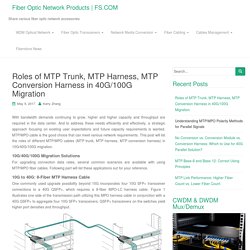
And to address these needs efficiently and effectively, a strategic approach focusing on existing user expectations and future capacity requirements is wanted. MTP/MPO cable is the good choice that can meet various network requirements. This post will list the roles of different MTP/MPO cables (MTP trunk, MTP harness, MTP conversion harness) in 10G/40G/100G migration. Understanding MTP/MPO Polarity Methods for Parallel Signals. When migrating from 10G to 40G/100G, it is important to know the MTP polarity and gender.
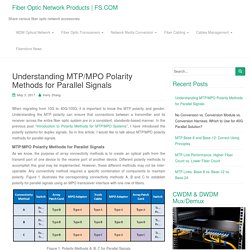
Understanding the MTP polarity can ensure that connections between a transmitter and its receiver across the entire fiber optic system are in a consistent, standards-based manner. In the previous post “Introduction to Polarity Methods for MTP/MPO Systems”, I have introduced the polarity systems for duplex signals. So in this article, I would like to talk about MTP/MPO polarity methods for parallel signals.
MTP/MPO Polarity Methods for Parallel Signals As we know, the purpose of array connectivity methods is to create an optical path from the transmit port of one device to the receive port of another device. Figure 1: Polarity Methods A, B, C for Parallel Signals Compared with polarity methods for duplex signals, there are two differences for parallel signals. No Conversion vs. Conversion Module vs. Conversion Harness. When talking about 40G cabling, MPO cable is the most common choice for data center managers to use.
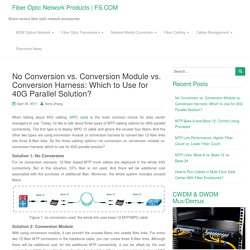
Today, I’d like to talk about three types of MTP cabling options for 40G parallel connectivity. The first type is to deploy MPO 12 cable and ignore the unused four fibers. And the other two types are using conversion module or conversion harness to convert two 12-fiber links into three 8-fiber links. So the three cabling options—no conversion vs. conversion module vs. conversion harness: which to use for 40G parallel solution?
Solution 1: No Conversion. MTP Link Performance: Higher Fiber Count vs. Lower Fiber Count. With the pre-terminated plug & play benefits and ease of scalability from 10-40-100G, MPO/MTP connectors are rapidly becoming the norm of switch-switch connections.

In the previous post “Introduction to MPO Connector”, I have talked about two types of MPO connectors—12 fiber MPO connector and 24 fiber MPO connector. And both the two MPO/MTP cable types can be used for 100G data transmission. So someone may ask “for MTP link performance, is there any difference between higher fiber count and lower fiber count, or, which produces better performance, higher fiber count or lower fiber count?”. This post simply tells the answer. MTP Base-8 and Base-12: Correct Using Principles. In my previous post “MTP Links: Base-8 vs.
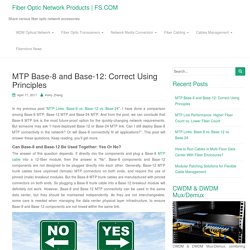
Base-12 vs. Base-24”, I have done a comparison among Base-8 MTP, Base-12 MTP and Base-24 MTP. And from the post, we can conclude that Base-8 MTP link is the most future-proof option for the quickly-changing network requirements. But someone may ask “I have deployed Base-12 or Base-24 MTP link. MTP Links: Base-8 vs. Base-12 vs. Base-24. For data center managers, deploying a fiber system that can easily be upgraded to future high-density network demands is the first thing that should be considered, because network reconfiguration would result in lots of time and money.

So it is essential to deploy a fiber network which is easier to upgrade to the higher data rates from the start. For high density MTP links, Base-8 vs. Base-12 vs. How to Run Cables in Multi-Floor Data Center With Fiber Enclosures? In the previous post—Modular Patching Solutions for Flexible Cable Management, I have introduced one kind of FHD fiber enclosure with user-friendly slide-out drawer and flexible mounting options.
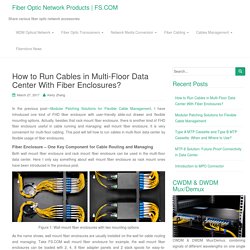
Actually, besides that rack mount fiber enclosure, there is another kind of FHD fiber enclosure useful in cable running and managing: wall mount fiber enclosure. It is very convenient for multi-floor cabling. This post will tell how to run cables in multi-floor data center by flexible usage of fiber enclosures. Fiber Enclosure – One Key Component for Cable Routing and Managing. Modular Patching Solutions for Flexible Cable Management. As is known to all, data center cable management is not that easy.
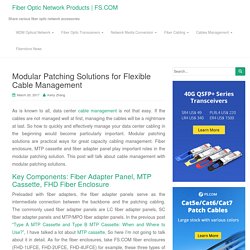
If the cables are not managed well at first, managing the cables will be a nightmare at last. So how to quickly and effectively manage your data center cabling in the beginning would become particularly important. Modular patching solutions are practical ways for great capacity cabling management. Fiber enclosure, MTP cassette and fiber adapter panel play important roles in the modular patching solution. This post will talk about cable management with modular patching solutions. Type A MTP Cassette and Type B MTP Cassette: When and Where to Use? Modular system, which allows for rapid deployment of high density data center infrastructure and improved troubleshooting and reconfiguration during MACs, is more and more popular.
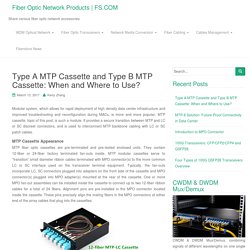
MTP cassette, topic of this post, is such a module. It provides a secure transition between MTP and LC or SC discreet connectors, and is used to interconnect MTP backbone cabling with LC or SC patch cables. MTP Cassette Appearance. MTP-8 Solution: Future-Proof Connectivity in Data Center. In most data centers, MTP cable is widely used for high density application.

MTP-12 connectivity and MTP-24 connectivity are the two common types of cabling connections, which use links based on increments of 12 and 24, such as 12-fiber trunk cables and 24-fiber trunk cables. Introduction to MPO Connector. Introduced several years ago, MPO connectors are now widely used around the world. They are designed to reduce the amount of time required for fusion splicing individual connectors. Combining lots of fibers in one connector, the MPO connector not only greatly reduces the time of connecting fibers, but also saves a lot of space. This post will introduce the detailed information about MPO connector. 100G Transceivers: CFP/CFP2/CFP4 and QSFP28. With bandwidth demands keep growing, network service providers are looking at 40G or 100G to accommodate the constant traffic surge. For 40G QSFP+ transceivers, they are interfaced with MTP/MPO or LC connectors, which has been introduced in a previous post: 40G Transceivers With MTP/MPO Interface vs. 40G Transceivers With LC Interface.
So this article will introduce 100G transceivers (CFP/CFP2/CFP4/QSFP28) which have different interface types. 100G Transceivers Standards. Four Types of 100G QSFP28 Transceivers Overview. For 100G optical transceivers, there are a number of form factors including CFP/CFP2/CFP4, CXP and QSFP28. Among these different 100G form factors, it appears that the market has chosen QSFP28 as the primary form factor for 100G links.
Hence, this post will focus on several types of 100G QSFP28 transceivers—100GBASE-SR4 QSFP28 transceiver, 100GBASE-PSM4 QSFP28 transceiver, 100GBASE-LR4 QSFP28 transceiver, and 100GBASE-CWDM4 QSFP28 transceiver. 100GBASE-SR4 QSFP28 Transceiver The 100GBASE-SR4 QSFP28 transceiver is a parallel 100G optical transceiver. It provides increased port density and total system cost savings. How to Set up Wireless Network? – Fiber Optic Network. A wireless network is completely wireless, which means that any device with a WiFi networking card installed will be able to access the Internet provided you have the right password.
Wireless networks are surely convenient for the daily life. This post tells about the things you should consider before building the wireless network, and then list the procedures of setting up wireless network. Things to Consider Before Taking Action Before building your own wireless network, you should make clear the following points. PON Fault Scenarios and Troubleshooting Basics. A PON network consists of an OLT connected via a PON splitter to multiple ONTs (one for each subscriber, up to 64 subscribers). Sometimes, a second splitter can be connected in cascade to the first splitter to dispatch services to buildings or residential areas, which has been introduced more clearly in the previous post “Understanding the Split Ratios and Splitting Level of Optical Splitters”.
This post will tell about troubleshooting of a point-to-multipoint FTTH network, also defined as a PON network. PON Fault Scenarios Scenario 1: Simple PON (only one customer is affected) There are three potential faults when only one subscriber cannot receive service—fault in the distribution fiber between the customer and the closest splitter, or fault in the ONT equipment, or fault in the customer’s home wiring. Fiber Optic Splicing Basis - Fiber Optic Network Products. Managed Media Converter and Unmanaged Media Converter Basics - Fiber Optic Network Products. As is known to all, fiber media converter is a simple networking device which can connect two dissimilar media types such as twisted pair cable with fiber optic cable.
And it can support many different data communication protocols including Ethernet, Fast Ethernet, Gigabit Ethernet, etc. According to the network to points, media converters can be divided into managed media converters and unmanaged media converters. Introduction to the Components Used in CWDM System - Fiber Optic Network Products.
CWDM system is a passive optical solution for increasing the flexibility and capacity of existing fiber lines in high-speed networks. It increases fiber capacity by placing widely spaced, separate wavelengths (between 1310 nm and 1610 nm) from multiple ports onto a single-mode fiber pair on the network. How to Use Fiber Splice Tray? - Fiber Optic Network Products. How Much Do You Know About PM Patch Cables? - Fiber Optic Network Products. Mode Conditioning Patch Cables Overview - Fiber Optic Network Products. Fiber optic patch cables play an important role in fiber optic connection. Introduction to the Components Used in DWDM System - Fiber Optic Network Products.
DWDM is an innovation that enables multiple optical carriers to travel in parallel in a fiber. DWDM devices combine the output from several optical transmitters for transmission across a single fiber. The ABCs of Fiber Enclosure Choosing Considerations - Blog of FS.COM. All fibers are eventually terminated, spliced, patched and stored in some sort of fiber enclosure. There are thousands of fiber enclosures suppliers in the market to offer all kinds of fiber enclosures. How to choose a good one from them?
Knowing your ABCs is critical in choosing the right enclosure for your network. Understanding the Split Ratios and Splitting Level of Optical Splitters - Fiber Optic Network Products. Optical splitters play an important role in FTTH PON networks where a single optical input is split into multiple output, thus allowing a single PON interface to be shared among many subscribers. The optical splitters have no active electronics and don’t require any power to operate. Guide for Choosing the Right Fiber Optic Cable - Fiber Optic Network Products. Fiber optic cable is a very thin glass strand through which a pulse of light is transmitted.
Nowadays, fiber optic cable is a desirable cable medium due to its immunity to electromagnetic interference (EMI) and radio frequency interference (RFI). It can transport optical signals for significant distances, whether in local area, wide area, or in metropolitan area. This article will tell some information about fiber optic cables and aim at providing a guideline on choosing the right fiber optic cable. Traditional CWDM Mux/DeMux vs. FMU Series CWDM Mux/DeMux - Fiber Optic Network Products. With the need for bandwidth increasing, the WDM (wavelength division multiplexing) technology was developed to expand network capacity over a single fiber. It uses a multiplexer (Mux) at the transmitter to combine several signals together, and a demultiplexer (DeMux) at the receiver to split them apart. FBT Splitters vs. PLC Splitters: What Are the Differences? - Fiber Optic Network Products. Basis of Pre-terminated Trunk Cable Assemblies - Fiber Optic Network Products.
Single-mode Fiber vs. Multimode Fiber: Which to Choose? - Fiber Optic Network Products. 40GBASE-SR4 vs. 40GBASE-SR BiDi: Which One Provides Higher Return of Investment (ROI)? - Fiber Optic Network Products. Introduction to Polarity Methods for MTP/MPO Systems - Fiber Optic Network Products. 24-Fiber Trunk Cabling – A Better Solution for 10-40-100G Migration - Fiber Optic Network Products. Field Terminated vs. Pre-Terminated: Which Do You Prefer? - Blog of FS.COM. How to Install Slide-Out Fiber Patch Enclosure - Blog of FS.COM. FS.COM LC Fiber Patch Cables Solution - Fiber Optic Network Products. FS.COM Special Offers on Ready-Stock LC. CWDM & DWDM Mux/Demux Overview - Fiber Optic Network Products. How to Use Fiber Enclosure in Data Center - Blog of FS.COM. What Will Data Center Benefit From MPO/MTP Solutions? - Blog of FS.COM. 40G Transceivers With MTP/MPO Interface vs. 40G Transceivers With LC Interface - Fiber Optic Network Products.
Pre-terminated Solutions for Data Center MDA, HDA and EDA Cabling - Blog of FS.COM. How to Use MPO/MTP Cassettes for 10G, 40G & 100G Connectivity? - Blog of FS.COM. Introduction to High-density Modular System and Cabling Options - Introducton to Fiber Optic Network Products from Fiberstore. Affordable 10G Network Over CWDM up to 18 Channels - Blog of FS.COM. Modular Patch Panel and Breakout Cabling: Which to Choose for Future-Proofing Network? - Introducton to Fiber Optic Network Products from Fiberstore. FS.COM Introduced HD MTP/MPO Cassettes Solution. What Can High-density Fiber Patch Panel Achieve? - Introducton to Fiber Optic Network Products from Fiberstore.
FS.COM. LC Fiber Patch Cords. Keyed LC Connectivity Solutions Ensure a Secure Fiber Network - Introducton of Fiber Optic Network Products from Fiberstore. Are You Still Worried about Bending the Fiber Patch Cables? - Blog of FS.COM. FS.COM High-Speed Fiber Patch Cable Solutions - Blog of FS.COM. MTP/MPO Cable Assemblies Sales. The Six Subsystems of A Structured Cabling System - Blog of FS.COM. Secure Data Center Solution – Keyed LC Connection System - Blog of FS.COM.
High-density Cabling Solutions – Push-Pull TAB and LC Uniboot Fiber Patch Cables - Introducton of Fiber Optic Network Products from Fiberstore. FS.COM Introduced LC Uniboot Fiber Patch Cables. Introduction to 100G Fiber Optic Transceivers - Introducton of Fiber Optic Network Products from Fiberstore. Basic Knowledge About EDFA - Introducton of Fiber Optic Network Products from Fiberstore.
Use Direct Attach Cable Assemblies for Data Center Interconnection - Blog of FS.COM. DIY Your Own Smart Home Network - Blog of FS.COM. How to Design Your FTTH Network Splitting Level and Ratio? - Blog of FS.COM. Data Center Architecture Migration - Blog of FS.COM. 40G QSFP BiDi Transceiver – Cost-effective Solution for Migration From 10G to 40G - Introducton of Fiber Optic Network Products from Fiberstore.
25 Gigabit Ethernet Is Arriving to Make a Difference - Introducton of Fiber Optic Network Products from Fiberstore. 40G Solutions. Fusion Splice vs. Mechanical Splice. Cabling Options for 40G Data Center - Introducton of Fiber Optic Network Products from Fiberstore. Components and Architecture of GPON FTTH Access Network. Catalyst 4948E and Catalyst 4948E-F Cabling Solutions - Blog of FS.COM. HP FlexFabric 5700 Switch Series Optics Options - Blog of FS.COM. Dell N4032F Compatible Modules and Cables - Blog of FS.COM.
Cabling Solutions for 1 GbE and 10 GbE - Introducton of Fiber Optic Network Products from Fiberstore. Fiber Optic Transceivers Supported for Juniper EX4200 Switch - Blog of FS.COM. FS.COM Devotes Great Effort to the Active Optical Cables. Cisco ME 3400 Series Switches Cabling Details - Blog Of FS.COMBlog Of FS.COM. 40 gbase qsfp+ aoc and 40gbase sr4 qsfp+ transceiver, which is your c… OTDR Dead Zone Tutorial. Terminologies of WDM Technology. Instructions for 40G QSFP+ Transceiver Installation and Removing - Introducton of Fiber Optic Network Products from Fiberstore. WDM Optical Networking Solutions. In 2016, the 100G Transceivers Will Be More Affordable - Blog Of FiberstoreBlog Of Fiberstore.
Push pull tab patch cords make high density cabling easy and elegant. Development of 40GBASE-iSR4 QSFP+ Transceiver. 40 gbase sr4 qsfp+ transceiver interconnection cabling. Push-Pull Tab Patch Cords Make High Density Cabling Easy and Elegant. Three Factors to Consider for Smooth Migration to 40G. 40GBASE-SR4 QSFP+ Transceiver Interconnection Cabling. Factors That Limit Optical Transmission Distance - Kerry_Zhang. FS.COM Fiber Media Converter Solutions – Stable, Reliable & Affordable. Fiber media converter tutorial. Splice or Connector: Which to Choose for FTTH Drop Cable Installation? Article-Realm.com - Free Online Articles Directory. Causes of mechanical splice termination failures by luinanian. Standards and recommendation for fiber optic systems.
Simplex Fiber Distribution Boxes on FS.COM. 1xN Simplex PLC Splitter On FS.COM. BiDi Transceiver Modules For Gigabit Networks. Cable Distribution & Termination. Things You Should Know about Fiber Optic Connector Polishing. OLT & ONU Units.